
The Analog Department - March 2013
Notes & Observations
The Minus-K isolation platform
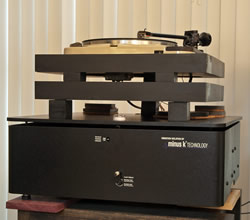 How I became involved:
How I became involved:
Out of the blue there was an e-mail from Dave Kushin, a media relations consultant representing Minus-K asking if I'd be interested in a demo unit for review. This offer having to do with a page on my website titled "What's Under Your Turntable" and my inclusion of a Minus-K isolation platform on that page. I said: Holy cow yes!!, I'd love to sample and review one of these. Then there were more email exchanges this time with Steve Varma of Minus-K and then a telephone conversation with Steve. This lead to the selection of a 150 BM-1 as the model for review in context with my equipment and listening room
What it is, origins etc.:
Minus-K isolation platform. Model: 150 BM-1. Designed to support and isolate from their surroundings sensitive instruments like scanning electron microscopes and other "nano technology" devices, (working way,,,,, way down to atomic structure levels of magnification), high powered telescopes, laser holography, and.........as a side benefit, it turns out that it works really well with record players. List Price: $4200
But what is it and how does it work...? Minus-K refers to their technology as "Negative Stiffness". It is passive. It does not use air or electricity. Rather than try to describe what does not (at first) seem intuitive to me, I offer the diagrams below taken from the Minus-K website.
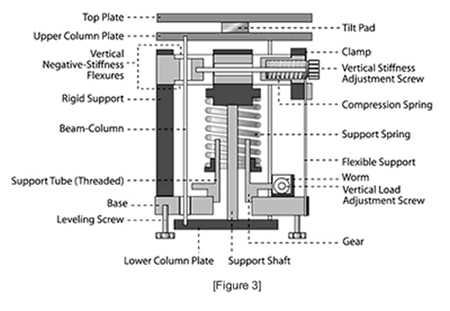
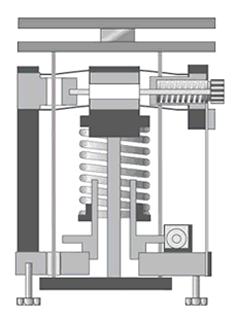
Who are they: Minus K Technology Inc., Vibration Isolation Systems. 460 S. Hindry Ave., Unit C Inglewood, CA 90301, Tel: 310-348-9656 Fax: 310-348-9638 https://minusk.com
- Principle inventor/designer: Dr. David Platus
- Benefits to home audio?
The platform isolates what stands on it from the surrounding structural environment as follows: horizontal isolation to 1/2hz or less.......vertical isolation to 1/2 hz with some variation depending on setting the device up. In other words, bang on the walls, stomp on the floor and no matter how badly the building structure vibrates, motion on top of the platform is restricted to 1/2 hz vertical and 1/2 hz horizontal (rotation). Please note I have yet to try the Minus-K during an earthquake event. Yet, I presume that it will provide substantial benefit during one of those as well. ;^)
Setting Up:
It was Monday evening. Around 6:30pm. Home from work and I had just finished a modest microwave dinner, sigh...... then there was a knock on the door. It was the UPS driver. I knew it was UPS because he always knocks the same. I opened the door and noticed he was empty handed. He said "I just wanted to make sure somebody was home before hauling this thing up the stairs". Good thinking, I said and made note that I was expecting a 90 lb package. Yup, he said, that would be the one. Using a hand truck, the driver wrestled the rather large cardboard box up to my unit. Just after I got the Minus-K inside the remainder of my Monday evening was spent setting up the platform in hopes of getting in a preliminary listening session before it was time for lights out.
But you know, one really should follow the instructions on the "Quick Start installation and adjustment guide". I was tempted to ignore these but always found myself coming back to the guide!! It's not complicated. But read the guide first.
Important parts: What you put on top of the platform needs to meet the weight requirements of the model. This unit I have is the 150 BM-1. Designed to carry 90 to 155 lbs. The load 'center of mass' needs to be well centered to the platform or adjustments won't be successful. As it turned out in the beginning, I either had too much weight, or not enough. That meant I could not use my granite surface plate beneath the TT plinth (too heavy) Then I found that the Double layered solid and massive slate plinth supporting the Thorens TD124 was almost but not quite heavy enough to meet the minimum weight requirements. So....I went out to the garage and rounded up some lead plate remnants I keep around for various elaborate and nefarious projects of my own.
In total I had about 20 lbs of lead plates cut into 7 or eight clean individual smaller pieces. I put these segments over cork pads to protect the finish on the Minus-K. This allowed me to add and -strategically- locate the weights over the platform surface until a decent adjustment of the unit was achieved. Whew! It did take some work moving the weights around, adjusting the level screws on the bottom of the Minus-K. But when in the zone, I found that the adjustments for vertical and horizontal position finally did work out as advertised. And then the vertical stiffness adjustment is used to alter the frequency of vertical oscillations. And this did dramatically adjust vertical oscillation from about 3 hz, when I first got the thing working, and then finally down to what must be close to the 1/2 hz goal.
When finally adjusted I noticed that slight finger-tip pressure on top of the TT plinth resulted in a very, very slow vertical (up and down) motion and, at the same time, some very very slow horizontal rotation. I also noticed that, as I walked around the unit without touching any part of the TT stand, my footsteps would trigger this type of very slow motion. This was very telling. The TT stand without this isolation was constantly being disturbed by the room's occupants and their walking around. But up on top of the platform, these disturbances were reduced to 1/2 hz motion in both horizontal and vertical planes.
Thinking about the benefit;
Thinking of the size of the record groove in the stereo Long play record. Thinking of the job that the tonearm has to do in order to allow the stylus, itself microscopic in size, to maintain its geometric orientation while, at the same time, tracking and reading the terrain of the groove. Thinking of the forces applied to that stylus in order for it to remain in the groove. And then thinking of how small of an external force it would take to even slightly disturb this process. Not much force. Now, think if all external forces were removed from the record playing process and all the stylus and tonearm had to cope with was the record groove itself. Don't you think sound quality might improve...? My answer would be; "of course it should".
Listening and operating
This is the fun part. Once the Minus-K is dialed-in for load I get to play many many records over many, many days.
First things noticed: Background noise is lower. Micro detail better articulated. Slightly deeper, better defined bass notes. Tones and textures seem very slightly enhanced. The record player now articulates more of what resides within the groove. Did I mention that I can now jump up and down next to the record player with nary a skip? Perhaps in some listening rooms that would be the largest, most obvious benefit. But sound quality improvements are another benefit.
I've been playing records from every genre within my library. Full scale symphonic, to chamber music to rock & roll to small combo jazz. Everything I like to play, I've been playing during this period of review. In every case I heard small but noteworthy improvements in the quality of reproduction.
- Sibelius/Burglund on EMI
- Mahler/Abravanel on Vanguard
- Beethoven String Quartets/ Quartetto Italiano / Philips
- Bruckner/ Haitink / Philips
- Santana / ST & Abraxas on Columbia
- Led Zeppelin II & III (Classic Records)
- Miles Davis / J. Coltrane from the Mosaic Box
- Brubeck / Time Further Out, Time In ( Columbia )
- Roxy Music / Avalon /(Warner Bros)
- Pentangle - Basket of Light (Earmark / Transatlantic)
- Cat Stevens - Tea... ( A&M )
- Beatles - Sgt. Peppers ( on Parlophone)
- etc
From Bach to Rock. From Miles to The Beatles. Every genre benefits from the less perturbed, more placid stylus-groove interface that the Minus-K provides. At first I thought that classical music recordings would be the obvious benefactor because performances show the largest dynamic range. Those recordings operate from near silence to full blast bombardments of musical content. And these recordings do benefit. The more silent backdrop offers this music in greater relief and definition. And then every other musical genre I sampled seemed to benefit similarly. And not just the delicate near silent bits. Very loud hard rock recordings were also reproduced in greater resolution and focus. The word "sharper" seems to be a descriptive term that matches my impression. As noted above, the sound quality differences were subtle but notable. If footfall is a problem you're trying to solve, the improvement should be much more than subtle. This device, properly set up should provide the ultimate solution.
Operating note: Touch the turntable and everything on top of the platform goes into motion. If touched gently, movement is small. If touched more firmly, movement is larger in proportion to the force from your hands. This takes a little getting used to. Probably the biggest trial is brushing the stylus clean. I use a stiff stylus brush each record side. This requires a bit more effort and close attention in order to control the hand operation.....and it is always possible to bend or break a cantilever if you have an accident while attempting to brush it clean...! One should not have too many shots of bourbon prior to doing this.......
So far, so good. I may adopt a different stylus cleaning regimen. The Onzow Zerodust cleaner allows one to place the pad on record (not spinning) and simply drop the stylus on it, then lift off without moving the pad. That works fine with the TD124 which has clutch mechanism that lifts the upper platter off the spinning flywheel beneath and parks it stationary. With a different turntable, the platter would need to be stopped using this particular cleaner.
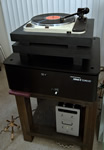 Summary and conclusions.
Summary and conclusions.
It took me more than one adjustment session to get the Minus-K operating near its advertised 1/2 hz operating frequency. But now that I have some familiarity to the needs of the Minus-k I would be more adept at the next setup session
Perhaps it might be useful to compare the before and after befits with regard to having the Minus-K in my system. The "After' comparison tends to include the addition of a deeper vision into the micro detail parts of the recording. The faintly articulated bits, while still faint, now appear in sharper focus. The Macro bits also have sharper focus as well and appear more solidly described. There is a sense that bass performance is slightly enhanced in terms of bass impact, slam and also the sense that tone and timbre at this frequency are resolved in slightly higher resolution. Perhaps the idea that this device helps us to gain a slightly deeper view of the music within the groove is an appropriate way to describe the benefit it provides. Because with it we are allowed to peer further into the recording.
In case there was any question in my mind whether or not this platform would provide an audible benefit within my system, I am now satisfied that there is a benefit. Perhaps that benefit is a subtle one. But it is a benefit that I value.
Appearance: This platform is a piece of laboratory equipment and looks like it belongs in a lab rather than a listening room. So be it. The unit I have; 150 BM -1 is designed to carry from 90 lbs up to 155 lbs on its top plate. Looking within the unit, (with the back outer cover removed) we can see why the unit is so large. The mechanism is scaled up to a size capable of carrying its load. Smaller more compact models of the Minus-K, like the BM-8 series will have a much lower profile and a smaller area foot print. But they must carry lower weight loads. So, if your turntable weighs, in total, less than 30 lbs, there might be a more compact and lower priced model within the Minus-K catalog of platforms that would meet your needs.
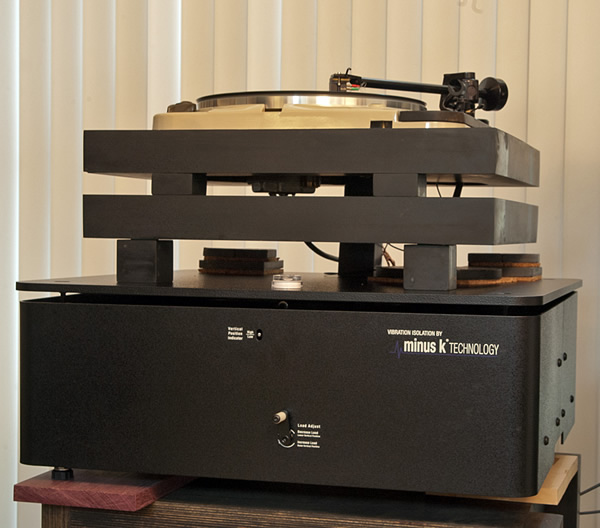
I did ask for permission to remove an outer cover so that I could take a peek inside and actually view the internal parts of this model. Permission was granted and so I have the following photographs:
 |
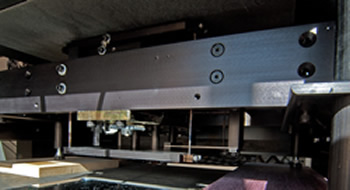 |
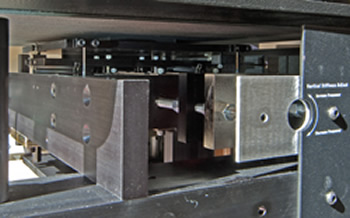 |
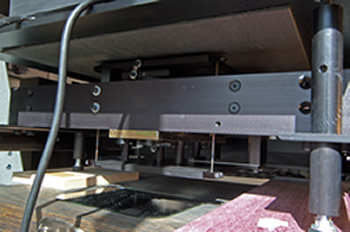 |
While taking the above photos it occurred to me that it might be useful to take a video of the platform while "working".
Next is a link to an Apple Quick-Time video I took of it. Just click on the "In motion" text to view the video.
In motion
Appologies in advance; My video is low-resolution (vga) and peers through a rather cheap lens of a 'point and shoot'. But you should be able to see the speed with which this suspension oscillates.
More Photos and notes:
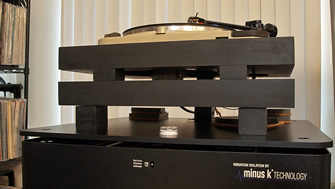 |
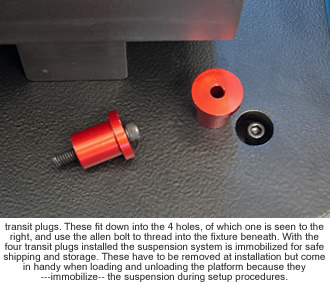 |
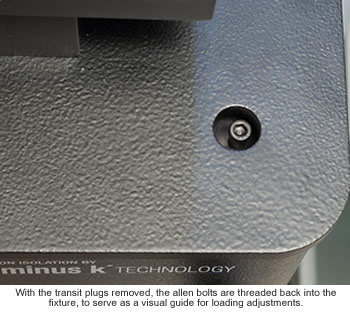 |
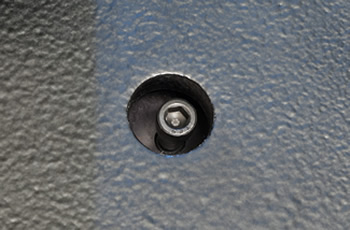 |
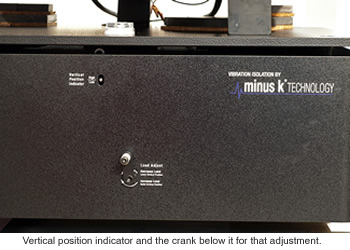 |
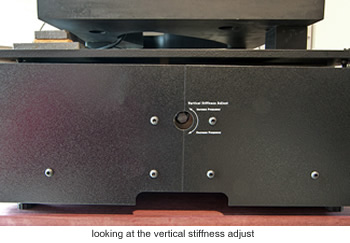 |
The listening continues................. and a good time was had over at chez The Analog Dept. :-)